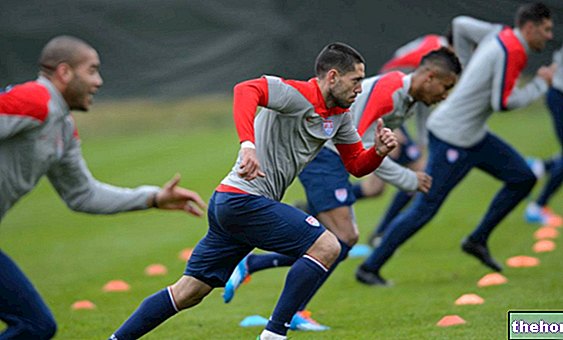Edited by Dr. Davide Sganzerla
In general, Resistance is defined as the psychophysical capacity to resist fatigue, ie the ability to withstand long efforts and fatigue but also the ability to perform an activity repetitively (Conseman).

Resistance training is important because:
- increases physical performance capacity;
- improves the ability to recover by eliminating the waste produced by fatigue more quickly;
- reduces trauma, which derives from the fatigue of the Central Nervous System;
- increases the psychic carrying capacity, increasing the resistance to stress;
- avoids the decrease in the functional capacity of the Central Nervous System, as there is a better capacity for recovery that does not compromise concentration and reactivity;
- it decreases the technical and tactical errors due to the high concentration during the match;
- it maintains healthy and stable health because it increases the immune system.
It is important to develop Resistance according to the needs of the discipline: an excess of Resistance negatively affects speed, explosive strength and can lead to a condition of "overtraining" or overtraining that worsens the ability to perform.
Resistance training improves the athlete's aerobic power. It is the intensity of the aerobic system and is the ability to produce aerobic energy at a high rate per unit of time; it is evaluated with the VO₂max (Maximum Volume of Oxygen that can be consumed per minute), which represents the highest expression of the ability to produce muscle work using aerobic metabolism.
The improvement of aerobic power causes the athlete the following advantages:
- ATP is produced with the aerobic mechanism at high intensity;
- the oxygen debt is less and the recovery is faster the greater the aerobic power both in an aerobic and anaerobic regime;
- the greater the degree of aerobic power, the greater the capacity for extensive work and the greater the resilience.
The methods of resistance training in football
From a physiological point of view, the methods of resistance training can be divided into four main groups:
- CONTINUOUS LOADING METHODS: the purpose of these methods is to improve aerobic capacity; they are divided into:
- CONTINUOUS EXTENSIVE: purely aerobic training oriented on the metabolism of fats characterized by long and very long runs (+ volume, - intensity), useful for aerobic capacity but null for training Aerobic Power.
- CONTINUOUS INTENSIVE: resistance training based on prolonged work in anaerobic threshold, therefore ideal for training aerobic power; they are very hard work from a psychic point of view and are based on the use and demolition of carbohydrates present in the muscle.
- INTERVAL METHODS: it is a resistance training method where considerable stimuli are applied to enlarge the heart, improve glucose metabolism, and increase aerobic and anaerobic capacity. These are stimuli of different intensity, volume and length of distance that are alternated with each other during training. Typical of this method is the advantageous or rewarding pause, that is the active pause phase characterized by slow running where the athlete recovers between one stimulus and the other.
- REPETITION METHODS: these methods provide for the repeated execution of a chosen distance that is covered each time at the maximum possible speed after having completely recovered from the previous test. The recovery time from one repetition to another depends on the duration of the repetition itself, however the pause must be complete and is aimed at preventing an early build-up of fatigue.
The repetition methods are valid for all three types of Resistance (short, medium and long duration) and are very effective for improving Special Resistance, for improving the mechanisms of regulation of the cardiovascular, respiratory and anaerobic metabolism systems. - METHODS BASED ON THE GAME OR ON THE COMPETITION: they represent the most global and truthful methods as they simultaneously train all the special Endurance skills necessary to play football. The games are then used to train specific resistance using the technical-tactical and mental aspects of the athlete.
Examples: 1vs1;
2vs2;
3vs3;
Ball possessions;
Finishing on goal with retraction.
Examples: 20 "stroke in threshold S2;
20 "stroke at 50/60% HR max.
Examples: 04 "/ 06" threshold travel S4;
04 "/ 06" stroke at 80/90% HR max.
Examples: 1 "run at 80/90% fc max alternating with 2" run at 50% fc max for 9/12 ";
2 "threshold run S4 alternating with 2" threshold run S2 for 10/12 ";
100m extension alternating with 300m slow run for 8/10 ".
Examples: 4x1000m performed at the maximum possible speed complete recovery;
6x 300m carried out at the maximum possible speed complete recovery;
10x100m carried out at the maximum possible speed complete recovery.
Special methods for training endurance in football
- RUN WITH VARIATIONS OF SPEED "(CCVV): Method based on the stimulation of the formation of lactic acid to favor at the same time its elimination through its reuse as fuel. Lactate production is caused by short changes in speed followed by periods of active recovery with slow running. which avoids the inhibition of unwinding due to lactate. Running with speed variations can be based on distances in meters or distances based on time.
Examples in m: 10m fast, 10m slow, 20m fast, 20m slow, 30m fast, 30m slow for 6/8 ";
5m fast, 5m slow, 10m fast, 10m slow, 15m fast, 15m slow for 6/8 ";
10m fast, 20m slow, 20m fast, 40m slow, 40m fast, 80m slow for 6/8 ";
40m fast, 10m slow, 10m fast, 40m slow;
Examples in sec: 3 "fast, 10" slow, 6 "fast, 20" slow, 9 "fast, 30" slow for 4/8 ";
5 "fast, 25" slow, 15 "fast, 45" slow for 6/8 ";
3 "fast, 7" slow, 6 "fast, 14" slow, 8 "fast, 22" slow for 6/8 ";
30 "fast, 30" slow, 20 "fast, 40" slow, 10 "fast, 50" slow by 6 ". - REPEATED AT A CONSTANT RHYTHM: Method based on repeated exercises and performed at a speed close to the anaerobic threshold, with recovery equal to the duration of the repetition.
Examples: 4x1000m in 4 "recovery 4";
8x300m in 1 "recovery 1";
10x100m in 20 "recovery 20". - INTERMITTENT: Method based on the repetition of short and medium duration exercises, in which the alternation between work and rest phases is very frequent. It is a very intense method as it subjects the transport system to a maximum load and of use of oxygen. The intensity of the exercise varies from 100% to 120% of the Maximum Aerobic Speed and recovery is at most double the execution time of the sprint; this allows you to maintain a frequency for the entire duration of the series. cardiac elevated and stable levels.
- COMETTI: Method based on the alternation of strength and endurance work; this method is used to affect the neuromuscular and organic parameters that influence the ability to resist.
- FARTLEK: Method characterized by distances ranging from 4Km to 10Km in continuous but varied running; the effort is therefore irregular with a percentage of different intensities. The race is characterized by accelerations, climbs, descents, sprints and stretches of slow running that are not predetermined. This method aims at oxygenation, so it improves aerobic capacity.
Examples: tot m in 10 "recovery 20" (120% of the vam) for 6 ";
tot m in 10 "15" recovery (115% of the vam) for 5 ";
tot m in 10 "recovery 10" (110% of the vam) for 4 ";
tot m in 30 "recovery 30" (100% of the vam) for 5 ".
Examples: 4 leaps 50cm, sprint 20m, slow run 50m for 6 ";
4 squat jumps, slalom with ball, 20m sprint slow run for 50m for 6 ".
BIBLIOGRAPHY:
- THE OPTIMAL TRAINING, JURGEN WEINECK, CALZETTI MARIUCCI EDITORE;
- THE OPTIMUM PHYSICAL PREPARATION OF THE PLAYER, JURGEN WEINECK, CALZETTI MARIUCCI EDITORE;
- MODERN METHODS OF MUSCLE ENHANCEMENT - PRACTICAL ASPECTS, GILLES COMETTI, CALZETTI MARIUCCI EDITORE;
- SPECIAL PREPARATION - METHOD - EXERCISES - LOADS, ALESSANDRO MARIANI, CALZETTI MARIUCCI EDITORE.




























